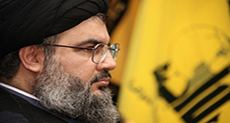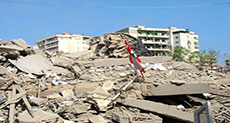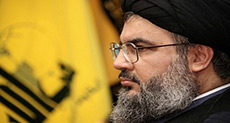
Bint Jbeil Battle Outlines Divine Triumph: “Spider-Web” Plot Foiled

By Ali as-Sagheer
Throughout the middle and recent history, Bint Jbeil has been home for liberation movements in southern Lebanon particularly and in Lebanon generally.
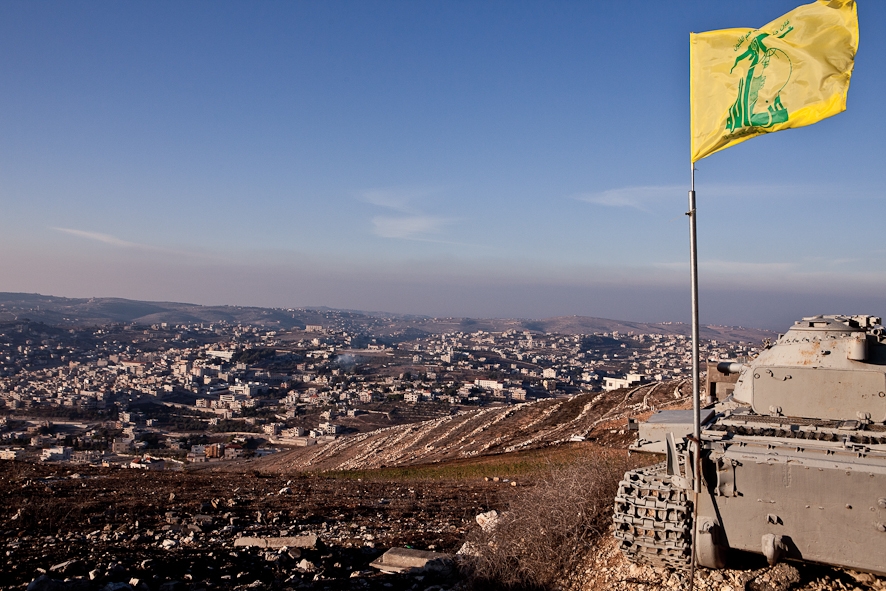 Bint Jbeil's has demonstrated the presence of different political parties including leftists and rightists. Bint Jbeil has as well been home for slogans of consolidation with the Arab and Islamic causes, sometimes with the international ones.
Bint Jbeil's has demonstrated the presence of different political parties including leftists and rightists. Bint Jbeil has as well been home for slogans of consolidation with the Arab and Islamic causes, sometimes with the international ones.
Thereon, this town of Mount Amel has spontaneously been part of the support for the Islamic Resistance that crowned its struggles with the liberation in 2000.
The central part of Mount Amel regained its leading role as to embracing the Resistance, just like it had done to the other resistance movements along the Ottoman Reign through the French Mandate. As a matter of fact, the title "Resistance and Liberation Capital", which His Eminence Sayyed Hassan Nasrallah honored Bint Jbeil with, expresses its history as well as its present: a struggling town.
Intrigues
The battle did not end when the "Israeli" enemy withdrew from South Lebanon in May 2000. This strategic, significant event rather altered the "Israeli" view on "Israel's" enemy in the north: The "Israeli"-Arab struggle was now different, and "Israel's" enemy in the north refuted the claims that "Lebanon's power was its very own weakness" and that "a weak side can never fight a powerful one back". In particular, the triumph speech the Resistance Master delivered on the 25th of May, 2000 in Bint Jbeil made the "Israeli" generals commence planning for evening the score of their military.
That is, His Eminence Sayyed Nasrallah said ""Israel" is weaker than a spider's web" and "it is no longer time for defeats", and his words be brought about enthusiasm to the Arab Nation and the Ummah. Afterwards, "Israel's" policy makers worked hard on making military plans to retaliate after the Resistance had delivered coups to them throughout the years before. The policy makers in reality sought to put an end to the public development of this corps (Hizbullah), which was gaining more of the Arabs' support. In 2004-2005, the United States and "Israel" coordinated to get these plans ready, and they only needed the right chance to strike the targets set by their different espionage bodies through the earlier period.
"Truthful Pledge"
On the 12th of July, 2006, the Islamic Resistance performed "Operation Truthful Pledge". In a few hours, the Resistance captivated two "Israeli" soldiers, killed eight others, and demolished three Merkava tanks of the fourth generation. That very fact was something neither the military command nor the political one could justify to the "Israeli" public. Therefore, talk of "striking back", "evening the score", and "bridling Hizbullah" increased. Obviously, the "Israeli" military was determined to begin a decisive battle with the Resistance, especially as the military received the support of regional and international powers.
During the first days of the "Israeli" aggression, the "Israeli" war aircraft struck so many targets. Bint Jbeil was the main target, however. During the second week of the aggression, the enemy said it was "Hizbullah's site" and "the capital of world terror". In fact, the enemy sought preparing all interested sides to occupy this city, which was only one km away from the borders of Lebanon with occupied Palestine.
The enemy was also determined to post the "Israeli" flag onto the same location where the Resistance master made a speech in May 2000.
After "Israel" claimed Maroun ar-Ras had fallen, it began preparing to seize Bint Jbeil. Earlier, "Israel" announced it "had no plans of occupying towns but rather establishing sites overlooking the towns so as to maintain fire control and monitoring... But in fact Bint Jbeil seemed rather exceptional to the enemy; "Israel" commenced readying its forces to occupy "the Resistance and Liberation Capital".
Actual Circumstances
The "Israeli" military command chose "Squadron 51" of the special-forces "Golani Brigade" to occupy Bint Jbeil. A few hours after "Squadron 51" attempted to do so, 8 soldiers were killed, several others were wounded, and violent clashes went on. Former Chief of "the Northern Command" General Audi Adam therefore admitted to reporters, "It's been a hard day!" Adam added that in two days of bitter combat, 10 soldiers had been killed, and "Israel" had failed to seize Bint Jbeil.
Tactically, the "Israeli" military chose three main axes to enter Bint Jbeil: On the west side, the military air-dropped a force onto Shalaaboun Hill (also known as Mas'oud Hill), and the force got positioned at a palace overlooking the town. On the east side, a motorcade approached Bint Jbeil-Aitaroun-Ainata-Maroun Square from Maroun ar-Ras. And on the south side, the third force got fortified at the entrance to Bint Jbeil by Yaroun, whereby the force made an overlooking palace at the reservoirs area an operation headquarters...
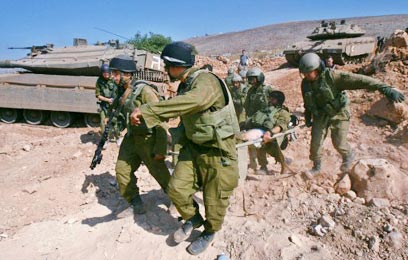
These forces, in fact, were primarily supposed to seize Bint Jbeil and progress inside it. The plan included leaving the north side opened to let the Resistance fighters "escape". That is, certain military tactics said attackers had to keep a missing link in the encompassment if they did not wish to undergo fierce battles with the fighters.
Introducing the forces' progress, the "Israeli" aircraft and artillery bombarded Bint Jbeil for 48 consecutive hours, whereby war planes carried out more than 500 airstrikes against the old town neighborhoods. For its part, the armored "Israeli" "Regiment 7" introduced the attack all through Monday, July 23 and Tuesday, July 24, preparing a regiment of engineers to demine hides and other places. As for the mission of a division of paratroopers, it was striking Hizbullah fighters. The infantrymen were supposed "to hold control over the zone and expand the campaign", the officers said.
Thus, the Zionist soldiers progressed, and Allah's devotees lurked. "It was a lethal ambush. We were attacked with machine guns, the shoulder-borne RPGs (Rocket-propelled grenades), and anti-tank missiles," declared an officer to "New York Times" as to the actual circumstances in the first days of the battles. Though the "Israelis" expected the Resistance fighters to resist, their information said "the last airstrikes and operations performed by "Israel" had finished Hizbullah's combat efficiency in Bint Jbeil and exterminated Hizbullah fighters remaining in town."
But a completely different story turned out to be true in the next few hours. To the soldiers of "Squadron 51", the priority was defending their souls and evacuating the wounded ones; the Resistance was making use of light and heavy artillery to carry out consecutive attacks on a range of axes. The "Israeli" military now acknowledged 9 soldiers were killed and 25 others were wounded.
The "Israeli" military commended the unit fighting in Bint Jbeil and stressed that Hizbullah had suffered grave casualties. The squadron commander, Captain Yanif Asor told "Yedioth Ahronoth" he was "ready for anything." The "Israeli" miniature security government, however, held a meeting that night to confer the outcomes of "Bint Jbeil Battle". The miniature government eventually decided that "no expanded ground campaign is to be carried out. The ministers have pointed out that intensifying airstrikes might offer an alternative that reduces casualties among the "Israeli" soldiers."
Nevertheless, the Resistance had prepared for a counterstrike...An "Israeli"- channel correspondent reported, "At 5 a.m. yesterday, (the 28th of July), the "Israeli" forces very carefully began breaking into Bint Jbeil (by "the Liberation Square"). The forces combed every single house and heralded their progress and accomplishments to the "Israeli" command every time they exposed a site, ditch, tunnel, or operation chamber of Hizbullah...
Only an hour had passed when it turned out that Hizbullah fighters had again ambushed the "Israeli" forces... The fighters suddenly attacked the occupying force with a barrage of machine guns, rocket shells, and RPGs (rocket-propelled grenades). The force, which had been allowed to progress several tens of meters, was perfectly besieged by Hizbullah fighters... The fighters were actually positioned along different axes to prevent the besieged soldiers from getting any provisions or contacting their command."
For the "Israeli" forces, the situation along the reservoirs axis wasn't any better. A major and a lieutenant participating in those battles said, "Being besieged in Bint Jbeil, the soldiers could not counterstrike the fire sources until an hour later; they hadn't been able to locate the fire sources among the surrounding buildings. Reinforcements and evacuation of the wounded soldiers took a big part of the day... The "Israeli" helicopters were even landing down 2 miles away (in occupied Palestine) so as to avoid the fire range of Hizbullah's fighters. The soldiers had to evacuate their wounded colleagues along two miles of a rough region covered by the fire of Hizbullah fighters until they got to the helicopters landing down while covered with gas grenades."
The "Israeli" forces on Mas'oud Hill in the west side were not luckier; that is, the Resistance kept the palace where the force was positioned under its fire range. "Israeli" aircraft kept supplying the soldiers with provisions before some bulldozers made a way through Rmeich-Ain Ebel to get more provisions to the soldiers. However, the force could not move a single step forward towards "Martyr Salah Ghandour's Hospital", where the force was supposed to get positioned. The "Israeli" military's strategic target beyond this progress, which was reaching "Headquarters 17", was foiled, therefore.
A sample of media military statements revealed the actual circumstances along that axis. The Islamic-Resistance Operation Chamber issued a statement: "Since the early morning hours, the Islamic-Resistance fighters have been violently combating the occupation forces along the axis of Mas'oud Hill, which overlooks Bint Jbeil. The fighters have demolished "Israeli" military vehicles and killed and wounded many "Israeli" soldiers. The "Israeli" military has been unable to remove the corpses from the battle field."
Another Islamic-Resistance statement followed: "Hizbullah fighters have succeeded at besieging a group of 18 "Israeli" soldiers and striking it with a barrage of fire and shells. As another eighteen-soldier group attempted rescuing the first, other Islamic-Resistance groups ambushed it."
Commenting on that, media sources said all 36 soldiers of both groups were wounded or killed; the "Israeli" forces were certain at least 8 of them were killed, 6 suffered a critical in jury, and 4 were missing. A spokesman for the "Israeli" military declared, "Eight soldiers were killed during the violent clashes with Hizbullah in Bint Jbeil surroundings."
Haji Om Ali Jouni, who insisted on serving the Resistance fighters all through the war, retells stories about the fighters hearing the "Israeli" soldiers screaming "Egoz... Egoz" every time the fighters ambushed them while they were trying to progress towards one of the schools of "al-Mabarrat Charity Association" near the hospital. Thus, the rest of the force hurriedly withdrew, leaving behind all of its technical and espionage equipment. The "Israeli" aircraft later carried out several airstrikes against the palace to demolish it completely and prevent the fighters from gaining that equipment.
"Uncreative Plans, Ghosts..."
The Islamic Resistance said the three "Israeli" progresses along the axes of Bint Jbeil had been expected, especially the airdrop onto Mas'oud Hill, where the enemy had carried out several airdrops while invading the South. This fact allowed the Resistance to take the initiative all through "Bint Jbeil Battle" and make the enemy unable to take the initiative or surprise the Resistance. "Winograd Committee" reported, "The "Israeli" command had uncreative plans during its war on Lebanon and lacked creativity in dealing with the actual circumstances." In fact, this exactly described "Bint Jbeil Battle", through which Hizbullah determined the right setting for striking the invading forces. Hizbullah fighters made their arms effective and prevented the enemy from exposing their numbers or the locations where the fighters set off on their mission.
Hereupon, the Zionist soldiers imagined they were fighting "ghosts"... They even described how the "ghosts" were dressed up and said they carried "swords" and "rode horses"... Many were the times when the soldiers escape from the battle field, getting shot in the back or falling into a state of involuntarily urination. A part of them still talk about the "ghosts" they shot but could not harm.
All in all, "Bint Jbeil Battle" reflected other battles on the lands of southern Lebanon. The heroic confrontations took place in Aita ash-Shaab, Maroun ar-Ras, Aitaroun, at-Taybeh, and al-Khiyam Plain. All over the confrontation axes, the fighters were evenly brave; they defended their nation in spite of all pressures.
Source: al-Intiqad, translated by moqawama.org
Throughout the middle and recent history, Bint Jbeil has been home for liberation movements in southern Lebanon particularly and in Lebanon generally.
 Bint Jbeil's has demonstrated the presence of different political parties including leftists and rightists. Bint Jbeil has as well been home for slogans of consolidation with the Arab and Islamic causes, sometimes with the international ones.
Bint Jbeil's has demonstrated the presence of different political parties including leftists and rightists. Bint Jbeil has as well been home for slogans of consolidation with the Arab and Islamic causes, sometimes with the international ones. Thereon, this town of Mount Amel has spontaneously been part of the support for the Islamic Resistance that crowned its struggles with the liberation in 2000.
The central part of Mount Amel regained its leading role as to embracing the Resistance, just like it had done to the other resistance movements along the Ottoman Reign through the French Mandate. As a matter of fact, the title "Resistance and Liberation Capital", which His Eminence Sayyed Hassan Nasrallah honored Bint Jbeil with, expresses its history as well as its present: a struggling town.
Intrigues
The battle did not end when the "Israeli" enemy withdrew from South Lebanon in May 2000. This strategic, significant event rather altered the "Israeli" view on "Israel's" enemy in the north: The "Israeli"-Arab struggle was now different, and "Israel's" enemy in the north refuted the claims that "Lebanon's power was its very own weakness" and that "a weak side can never fight a powerful one back". In particular, the triumph speech the Resistance Master delivered on the 25th of May, 2000 in Bint Jbeil made the "Israeli" generals commence planning for evening the score of their military.
That is, His Eminence Sayyed Nasrallah said ""Israel" is weaker than a spider's web" and "it is no longer time for defeats", and his words be brought about enthusiasm to the Arab Nation and the Ummah. Afterwards, "Israel's" policy makers worked hard on making military plans to retaliate after the Resistance had delivered coups to them throughout the years before. The policy makers in reality sought to put an end to the public development of this corps (Hizbullah), which was gaining more of the Arabs' support. In 2004-2005, the United States and "Israel" coordinated to get these plans ready, and they only needed the right chance to strike the targets set by their different espionage bodies through the earlier period.
"Truthful Pledge"
On the 12th of July, 2006, the Islamic Resistance performed "Operation Truthful Pledge". In a few hours, the Resistance captivated two "Israeli" soldiers, killed eight others, and demolished three Merkava tanks of the fourth generation. That very fact was something neither the military command nor the political one could justify to the "Israeli" public. Therefore, talk of "striking back", "evening the score", and "bridling Hizbullah" increased. Obviously, the "Israeli" military was determined to begin a decisive battle with the Resistance, especially as the military received the support of regional and international powers.
During the first days of the "Israeli" aggression, the "Israeli" war aircraft struck so many targets. Bint Jbeil was the main target, however. During the second week of the aggression, the enemy said it was "Hizbullah's site" and "the capital of world terror". In fact, the enemy sought preparing all interested sides to occupy this city, which was only one km away from the borders of Lebanon with occupied Palestine.
The enemy was also determined to post the "Israeli" flag onto the same location where the Resistance master made a speech in May 2000.
After "Israel" claimed Maroun ar-Ras had fallen, it began preparing to seize Bint Jbeil. Earlier, "Israel" announced it "had no plans of occupying towns but rather establishing sites overlooking the towns so as to maintain fire control and monitoring... But in fact Bint Jbeil seemed rather exceptional to the enemy; "Israel" commenced readying its forces to occupy "the Resistance and Liberation Capital".
Actual Circumstances
The "Israeli" military command chose "Squadron 51" of the special-forces "Golani Brigade" to occupy Bint Jbeil. A few hours after "Squadron 51" attempted to do so, 8 soldiers were killed, several others were wounded, and violent clashes went on. Former Chief of "the Northern Command" General Audi Adam therefore admitted to reporters, "It's been a hard day!" Adam added that in two days of bitter combat, 10 soldiers had been killed, and "Israel" had failed to seize Bint Jbeil.
Tactically, the "Israeli" military chose three main axes to enter Bint Jbeil: On the west side, the military air-dropped a force onto Shalaaboun Hill (also known as Mas'oud Hill), and the force got positioned at a palace overlooking the town. On the east side, a motorcade approached Bint Jbeil-Aitaroun-Ainata-Maroun Square from Maroun ar-Ras. And on the south side, the third force got fortified at the entrance to Bint Jbeil by Yaroun, whereby the force made an overlooking palace at the reservoirs area an operation headquarters...

These forces, in fact, were primarily supposed to seize Bint Jbeil and progress inside it. The plan included leaving the north side opened to let the Resistance fighters "escape". That is, certain military tactics said attackers had to keep a missing link in the encompassment if they did not wish to undergo fierce battles with the fighters.
Introducing the forces' progress, the "Israeli" aircraft and artillery bombarded Bint Jbeil for 48 consecutive hours, whereby war planes carried out more than 500 airstrikes against the old town neighborhoods. For its part, the armored "Israeli" "Regiment 7" introduced the attack all through Monday, July 23 and Tuesday, July 24, preparing a regiment of engineers to demine hides and other places. As for the mission of a division of paratroopers, it was striking Hizbullah fighters. The infantrymen were supposed "to hold control over the zone and expand the campaign", the officers said.
Thus, the Zionist soldiers progressed, and Allah's devotees lurked. "It was a lethal ambush. We were attacked with machine guns, the shoulder-borne RPGs (Rocket-propelled grenades), and anti-tank missiles," declared an officer to "New York Times" as to the actual circumstances in the first days of the battles. Though the "Israelis" expected the Resistance fighters to resist, their information said "the last airstrikes and operations performed by "Israel" had finished Hizbullah's combat efficiency in Bint Jbeil and exterminated Hizbullah fighters remaining in town."
But a completely different story turned out to be true in the next few hours. To the soldiers of "Squadron 51", the priority was defending their souls and evacuating the wounded ones; the Resistance was making use of light and heavy artillery to carry out consecutive attacks on a range of axes. The "Israeli" military now acknowledged 9 soldiers were killed and 25 others were wounded.
The "Israeli" military commended the unit fighting in Bint Jbeil and stressed that Hizbullah had suffered grave casualties. The squadron commander, Captain Yanif Asor told "Yedioth Ahronoth" he was "ready for anything." The "Israeli" miniature security government, however, held a meeting that night to confer the outcomes of "Bint Jbeil Battle". The miniature government eventually decided that "no expanded ground campaign is to be carried out. The ministers have pointed out that intensifying airstrikes might offer an alternative that reduces casualties among the "Israeli" soldiers."
Nevertheless, the Resistance had prepared for a counterstrike...An "Israeli"- channel correspondent reported, "At 5 a.m. yesterday, (the 28th of July), the "Israeli" forces very carefully began breaking into Bint Jbeil (by "the Liberation Square"). The forces combed every single house and heralded their progress and accomplishments to the "Israeli" command every time they exposed a site, ditch, tunnel, or operation chamber of Hizbullah...
Only an hour had passed when it turned out that Hizbullah fighters had again ambushed the "Israeli" forces... The fighters suddenly attacked the occupying force with a barrage of machine guns, rocket shells, and RPGs (rocket-propelled grenades). The force, which had been allowed to progress several tens of meters, was perfectly besieged by Hizbullah fighters... The fighters were actually positioned along different axes to prevent the besieged soldiers from getting any provisions or contacting their command."
For the "Israeli" forces, the situation along the reservoirs axis wasn't any better. A major and a lieutenant participating in those battles said, "Being besieged in Bint Jbeil, the soldiers could not counterstrike the fire sources until an hour later; they hadn't been able to locate the fire sources among the surrounding buildings. Reinforcements and evacuation of the wounded soldiers took a big part of the day... The "Israeli" helicopters were even landing down 2 miles away (in occupied Palestine) so as to avoid the fire range of Hizbullah's fighters. The soldiers had to evacuate their wounded colleagues along two miles of a rough region covered by the fire of Hizbullah fighters until they got to the helicopters landing down while covered with gas grenades."
The "Israeli" forces on Mas'oud Hill in the west side were not luckier; that is, the Resistance kept the palace where the force was positioned under its fire range. "Israeli" aircraft kept supplying the soldiers with provisions before some bulldozers made a way through Rmeich-Ain Ebel to get more provisions to the soldiers. However, the force could not move a single step forward towards "Martyr Salah Ghandour's Hospital", where the force was supposed to get positioned. The "Israeli" military's strategic target beyond this progress, which was reaching "Headquarters 17", was foiled, therefore.
A sample of media military statements revealed the actual circumstances along that axis. The Islamic-Resistance Operation Chamber issued a statement: "Since the early morning hours, the Islamic-Resistance fighters have been violently combating the occupation forces along the axis of Mas'oud Hill, which overlooks Bint Jbeil. The fighters have demolished "Israeli" military vehicles and killed and wounded many "Israeli" soldiers. The "Israeli" military has been unable to remove the corpses from the battle field."
Another Islamic-Resistance statement followed: "Hizbullah fighters have succeeded at besieging a group of 18 "Israeli" soldiers and striking it with a barrage of fire and shells. As another eighteen-soldier group attempted rescuing the first, other Islamic-Resistance groups ambushed it."
Commenting on that, media sources said all 36 soldiers of both groups were wounded or killed; the "Israeli" forces were certain at least 8 of them were killed, 6 suffered a critical in jury, and 4 were missing. A spokesman for the "Israeli" military declared, "Eight soldiers were killed during the violent clashes with Hizbullah in Bint Jbeil surroundings."
Haji Om Ali Jouni, who insisted on serving the Resistance fighters all through the war, retells stories about the fighters hearing the "Israeli" soldiers screaming "Egoz... Egoz" every time the fighters ambushed them while they were trying to progress towards one of the schools of "al-Mabarrat Charity Association" near the hospital. Thus, the rest of the force hurriedly withdrew, leaving behind all of its technical and espionage equipment. The "Israeli" aircraft later carried out several airstrikes against the palace to demolish it completely and prevent the fighters from gaining that equipment.
"Uncreative Plans, Ghosts..."
The Islamic Resistance said the three "Israeli" progresses along the axes of Bint Jbeil had been expected, especially the airdrop onto Mas'oud Hill, where the enemy had carried out several airdrops while invading the South. This fact allowed the Resistance to take the initiative all through "Bint Jbeil Battle" and make the enemy unable to take the initiative or surprise the Resistance. "Winograd Committee" reported, "The "Israeli" command had uncreative plans during its war on Lebanon and lacked creativity in dealing with the actual circumstances." In fact, this exactly described "Bint Jbeil Battle", through which Hizbullah determined the right setting for striking the invading forces. Hizbullah fighters made their arms effective and prevented the enemy from exposing their numbers or the locations where the fighters set off on their mission.
Hereupon, the Zionist soldiers imagined they were fighting "ghosts"... They even described how the "ghosts" were dressed up and said they carried "swords" and "rode horses"... Many were the times when the soldiers escape from the battle field, getting shot in the back or falling into a state of involuntarily urination. A part of them still talk about the "ghosts" they shot but could not harm.
All in all, "Bint Jbeil Battle" reflected other battles on the lands of southern Lebanon. The heroic confrontations took place in Aita ash-Shaab, Maroun ar-Ras, Aitaroun, at-Taybeh, and al-Khiyam Plain. All over the confrontation axes, the fighters were evenly brave; they defended their nation in spite of all pressures.
Source: al-Intiqad, translated by moqawama.org
